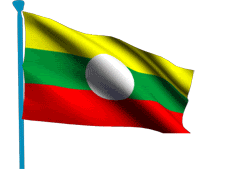Tai-Khamtis of Assam (မိူင်းတႂ်ႛၵံးတီႈ // ชาวไทคำตี่, อัสสัม)
 Assam Census Report 1881, para 153 : The Tai-Khamtis of the Narayanpur Colony in the North Lakhimpur subdivision.
Assam Census Report 1881, para 153 : The Tai-Khamtis of the Narayanpur Colony in the North Lakhimpur subdivision.-Mr. Stack
The Khamtis are nominally Buddhists, but the common people worship both Gautama, or "Kodoma" as they call him, and Debi or Durga. The Narayanpur colony is surrounded by Hindu villages, and I do not think that is an escape the subtle proselytising influence of Hinduism long. The Ahoms have almost entirely become Hindus now----only a few of the "Deodhais" (old Ahom priests) even remember the name of their ancient god "Chung" which was said to have been a brass image which was worshipped with mystic rites.. Whether this "chung" was "Gautama" or not it is now difficult to ascertain; but perhaps it was. The Ahoms have now entirely dropped their ancient faith as well as their language. The Khamtis keep Thursday holy as the birthday of Buddha, although they are not aware of the year of his birth. Their priests wear yellow robes, as do their Buddhist brethren in Burma. I notices this also in the Tairong and Nara villages I have seen. The holy books, as well as brass and stone images of Buddha, are kept in a prayer house (now called bapu ghar), generally a little distance
from the village. Women are not allowed to enter the "Bapu ghar", but the priest at the Tairong village I went to did not object to the male believer, although my wife was told to stand outside the house. Sir W. Hunter says that the majority of thr Khamti laity, as well as the priesthood, can read and write, and the chiefs pride themselves upon their manual dexterity in working in metals and in ornamenting their shields of buffalo or rhinoceros hide with gold and lac. The women also are saided to be skilled in embroidery...



No comments